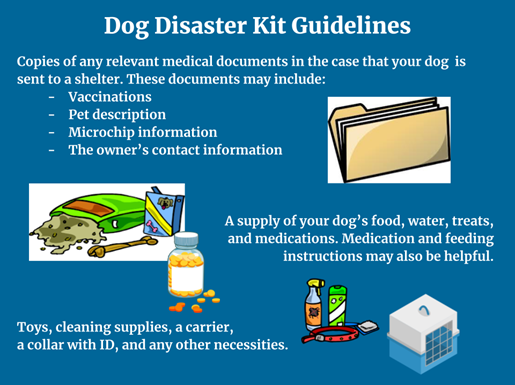Disaster in the air? Put your dog in good care.

If disaster strikes, do you have a plan for your pet? There are no shortage of stories of groups having to come into a disaster zone to rescue animals. It’s important to have a plan.
Setting the Scene:
In late August of 2005, Hurricane Katrina struck the Gulf Coast, creating irreparable damage to thousands of lives, homes, buildings, and animals. As a society, we learned a lot from the insufficient preparation for and handling of the natural disaster. Specifically, we learned how to better approach the care of pets during emergency situations. The best way to ensure the safety of your pets, mentally and physically, is to create an emergency kit and train them prior to a natural disaster.
According to the American Society for the Prevention of Cruelty to Animals, 83% of pet owners live in a region that is vulnerable to natural disasters. But a survey by ASPCA found that only 46% of owners had an emergency plan prepared. This data shows that there are still countless amounts of pets living in disaster prone areas that may face great danger at the expense of their owner’s negligence. This, however, is a simple fix. It is essential that every pet owner living in an area susceptible to disaster is prepared in order to prevent any more damage like that from Hurricane Katrina.
What is in a disaster kit?

You may be wondering, why should I prepare a disaster kit? By setting aside all your pets extra necessities, your dog is already guaranteed to be prepared to survive a new location (i.e. shelter), so you only have to worry about getting them through the emergency periods. Also, by taking care of your furry friend before a disaster, you can give more attention to other important issues. For example, if you have made preparations for your pup prior to an emergency situation, you can dedicate the time you would have spent gathering their food, medical documents, medication, and toys to your family, house, etc. While emergency kits are the most effective way to tangibly aid your pet during a disaster, there are other ways to prevent harm.
How can I train my pet for a disaster?
When disaster strikes, you may have to evacuate your home and flee to a safer location. In this case, you may have your hands (or car) full with necessities and valuables. You should not have to worry about holding your anxious pup or hoping they follow you. By crate training your dog, you are saving time and easing anxiety during emergency situations. While I haven’t experienced a natural disaster, I took the time to crate train my two doggies and it has even made car rides to the vet easier!
Additionally, it may be helpful to teach your dog a word, like “settle”, that cues them to relax. Whenever my two doggies are rambunctious, I use the phrase “find your bed”, and they always lay down which relaxes them. Crate training and word training will allow for efficiency and a sense of calm during stressful, emergency situations.
Easing potential doubts:
Some may argue that crate training creates premeditated anxiety for pets. For example, if the crate is also used for disciplinary purposes, your dog may resent it at the time of emergency. Additionally, if your dog stays in the crate for too long, it may develop severe bladder issues. Then, in emergency situations, the dog may be afraid to enter the crate because of their prior experience. But, although it may be daunting at first, there are steps you can take to ease the process and ensure a healthy relationship between your dog and their crate.

Following the above steps will ensure effective crate training, allowing you to focus on other important necessities and ensuring your dog to be safe during emergency situations. Now go get gathering materials for your doggie’s disaster kit and begin your training! It’s time to prepare and protect our dogs so they stay safe and we can focus on the other important things in our lives.
References
Barber, Ellen. 2019. “Lessons from Katrina: How to Keep Pets Safe in a Hurricane.” AnimalBiome. https://shop.animalbiome.com/blogs/pet-health/lessons-from-katrina-how-to-keep-pets-safe-in-a-hurricane.
Carpenter, Susan. 2021. “Natural disaster pet preparedness.” Spectrum News. https://spectrumnews1.com/ca/la-west/public-safety/2021/09/21/almost-half-of-pet-owners-forced-to-evacuate-during-a-disaster-left-animals-behind.
Gronwald, Andrea. 2020. “Why crate training your dog is important.” Animal
Wellness Magazine. https://animalwellnessmagazine.com/crate-training-dog/.
“Pet Safety in Emergencies | Healthy Pets, Healthy People.” 2021. CDC. https://www.cdc.gov/healthypets/keeping-pets-and-people-healthy/emergencies.html.
“Should You Crate Train Your New Puppy?” 2020. Windermere Veterinary Services. https://windermerevetservices.com/2020/12/04/should-you-crate-train-your-new-puppy-fnpo/.
“Weathering The Storm.” n.d. Cesar’s Way. Accessed April 4, 2022. https://www.cesarsway.com/weathering-the-storm/.




